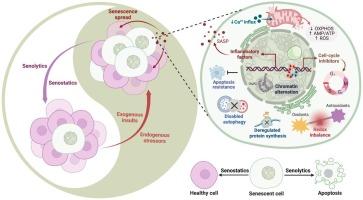Pursuing healthy aging and longevity through natural product and stem cell-driven rejuvenation
IF 5.6
2区 医学
Q1 PHARMACOLOGY & PHARMACY
引用次数: 0
Abstract
Aging is an inevitable biological process associated with progressive physiological decline and increased disease susceptibility. Cellular senescence stands as a key mechanism among the hallmarks of aging, which is characterized by irreversible cell-cycle arrest, chromatin remodeling, and a pro-inflammatory senescence-associated secretory phenotype (SASP). Importantly, SASP drives inflammaging and propagates senescence via a bystander effect, exacerbating tissue dysfunction. Recent advances in senolytic therapies and senostatics offer promising strategies to eliminate or rejuvenate senescent cells, improving physiological function in aged and disease models. Notably, panobinostat has emerged as an effective post-chemotherapy senolytic, mitigating chemoresistance. However, current senolytics face challenges, including off-target effects and limited clinical applicability. Growing evidence highlights natural products (e.g., polyphenols, flavonoids) and stem cell therapies as potential anti-aging interventions, with demonstrated efficacy in age-related disease models and ovarian rejuvenation. Despite progress, key hurdles remain in developing personalized, multi-target therapies that safely modulate aging trajectories. This review explores the mechanisms of cellular senescence, anti-aging mechanisms of phytochemicals, and phytochemicals and stem cell-therapy in ovary rejuvenation. We further discuss the challenges in developing “tailor-made” anti-aging interventions that rewire the aging trajectory, which will be critical for achieving healthy aging.

通过天然产品和干细胞驱动的返老还童,追求健康的衰老和长寿。
衰老是一种不可避免的生物过程,与进行性生理衰退和疾病易感性增加有关。细胞衰老是衰老标志中的一个关键机制,其特征是不可逆的细胞周期阻滞、染色质重塑和促炎性衰老相关分泌表型(SASP)。重要的是,SASP通过旁观者效应驱动炎症和传播衰老,加剧组织功能障碍。抗衰老疗法和静力学的最新进展为消除或恢复衰老细胞,改善衰老和疾病模型的生理功能提供了有希望的策略。值得注意的是,panobinostat已成为一种有效的化疗后抗衰老药,减轻化疗耐药。然而,目前的抗衰老药物面临着脱靶效应和临床适用性有限等挑战。越来越多的证据表明,天然产物(如多酚、类黄酮)和干细胞疗法是潜在的抗衰老干预措施,在与年龄相关的疾病模型和卵巢年轻化方面已被证明有效。尽管取得了进展,但在开发个性化、多靶点、安全调节衰老轨迹的疗法方面仍存在关键障碍。本文就细胞衰老机制、植物化学物质抗衰老机制以及植物化学物质与干细胞治疗在卵巢年轻化中的作用进行了综述。我们进一步讨论了开发“量身定制”的抗衰老干预措施所面临的挑战,这些干预措施将重新连接衰老轨迹,这对实现健康老龄化至关重要。
本文章由计算机程序翻译,如有差异,请以英文原文为准。
求助全文
约1分钟内获得全文
求助全文
来源期刊

Biochemical pharmacology
医学-药学
CiteScore
10.30
自引率
1.70%
发文量
420
审稿时长
17 days
期刊介绍:
Biochemical Pharmacology publishes original research findings, Commentaries and review articles related to the elucidation of cellular and tissue function(s) at the biochemical and molecular levels, the modification of cellular phenotype(s) by genetic, transcriptional/translational or drug/compound-induced modifications, as well as the pharmacodynamics and pharmacokinetics of xenobiotics and drugs, the latter including both small molecules and biologics.
The journal''s target audience includes scientists engaged in the identification and study of the mechanisms of action of xenobiotics, biologics and drugs and in the drug discovery and development process.
All areas of cellular biology and cellular, tissue/organ and whole animal pharmacology fall within the scope of the journal. Drug classes covered include anti-infectives, anti-inflammatory agents, chemotherapeutics, cardiovascular, endocrinological, immunological, metabolic, neurological and psychiatric drugs, as well as research on drug metabolism and kinetics. While medicinal chemistry is a topic of complimentary interest, manuscripts in this area must contain sufficient biological data to characterize pharmacologically the compounds reported. Submissions describing work focused predominately on chemical synthesis and molecular modeling will not be considered for review.
While particular emphasis is placed on reporting the results of molecular and biochemical studies, research involving the use of tissue and animal models of human pathophysiology and toxicology is of interest to the extent that it helps define drug mechanisms of action, safety and efficacy.
 求助内容:
求助内容: 应助结果提醒方式:
应助结果提醒方式:


